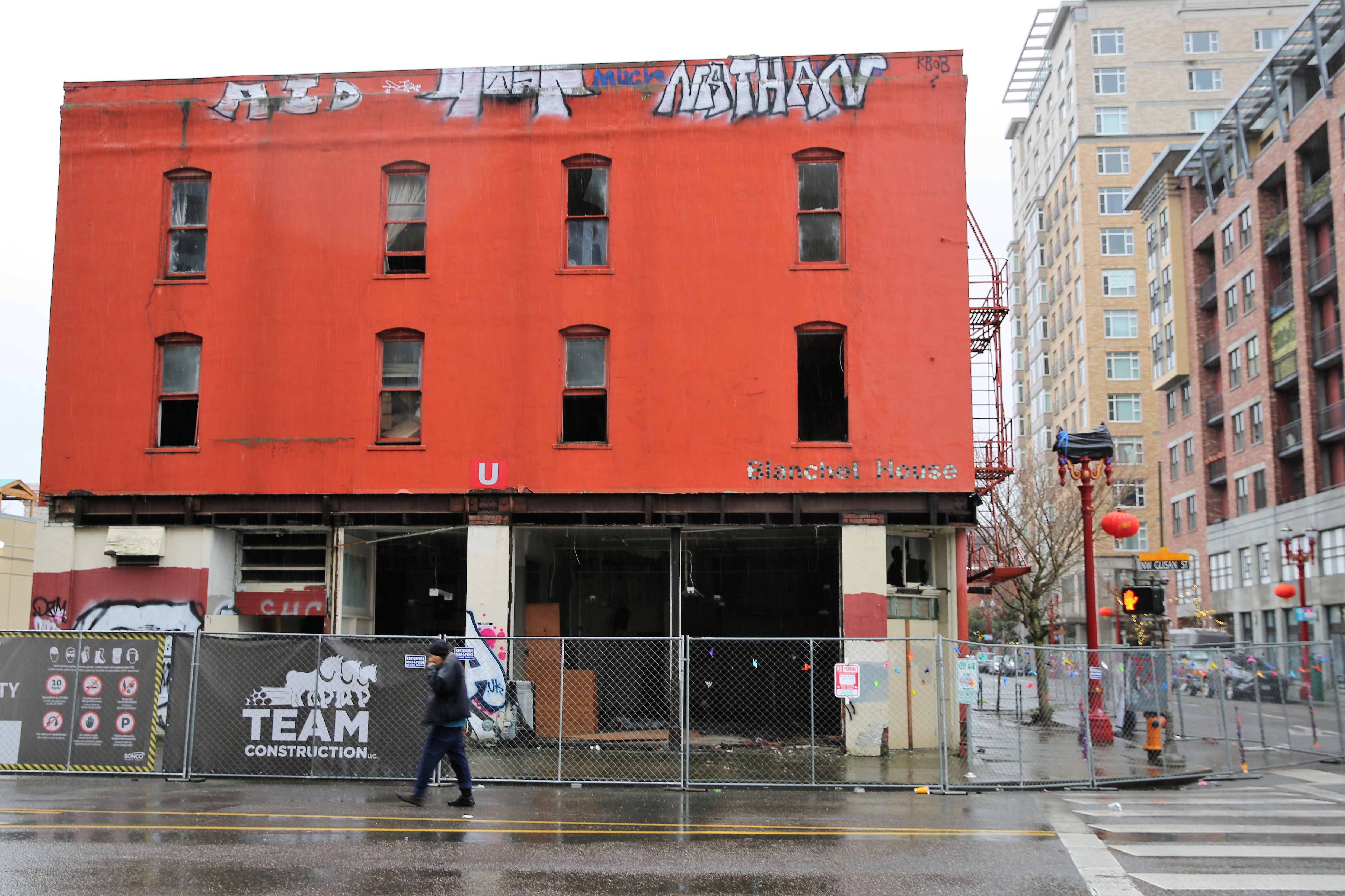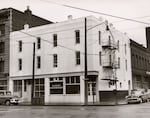
Demolition has started at the Blanchet House-owned former Yamaguchi Hotel which has stood vacant for 11 years, in this photo from March 13, 2023. Portland, Ore., officials classified it as dangerous, because of falling bricks and the fact that unreinforced masonry buildings can fail dramatically in earthquakes.
Kristian Foden-Vencil / OPB
Demolition of the historic Yamaguchi Hotel, the last building in Portland’s New Chinatown/Japantown district with Japanese-American owners, has already begun. The front windows are gone, and the building is surrounded by a chain-link fence.
The unreinforced brick structure has stood at Northwest 4th Avenue and Glisan Street for about 130 years.
The street level has housed shops and bars. From 1921 to 1941, the Yamaguchi family ran the top two floors of a hotel. Masae Yamaguchi served as a midwife in the area, an important role for a community that had difficulty accessing health care.
“It really is a symbol for a history that has often been forgotten,” said Chisao Hata, with the Japanese American Museum of Oregon, which stands kitty-corner to the old building.

The Yamaguchi Hotel building in its earlier form. Date unknown.
Oregon Historical Society
“That is the history of over 300 businesses of Japanese Americans living in this area, of schools and churches and business and markets and stores and watchmakers and barbers – all kinds of community people that really had to live in this area. They didn’t have much choice.”
Racism and redlining made the area one of the only places immigrants could settle in 20th Century Portland.
In February 1942, President Franklin Roosevelt issued Executive Order 9066, which authorized the removal of all people of Japanese ancestry — regardless of citizenship — from the West Coast. That effectively gutted Portland’s Japantown.
“This is a population that was forcibly displaced from this area,” said Mark Takiguchi, with the Japanese American Museum of Oregon. “About 50% never came back and some that did come back were not welcome.”
That history explains why a conglomeration of architects, historians and Japanese American civic leaders have been fighting the demolition of the Yamaguchi Hotel for years.
“Historic buildings tell stories and hold our histories. These buildings are more than just bricks,” Hata said.

Chisao Hata, with the Japanese American Museum of Oregon, photographed March 13, 2023. “It really is a symbol for a history that has often been forgotten,” Hata said of the Yamaguchi Hotel in Portland, Ore.
Kristian Foden-Vencil / OPB
The preservation nonprofit Restore Oregon has been fighting demolition,
“We mourn its upcoming demise,” said executive director Nicole Possert.
Today, the building is owned by Blanchet House, a nonprofit dedicated to helping people who are homeless or at risk of homelessness.
It started using the property in 1952 to serve meals. The street level had been an old bar. Blanchet House executive director Scott Kerman said the upstairs was being used as a brothel when the nonprofit bought the building in 1958.
For the last 11 years, the building has stood vacant. The city classified it as dangerous, because of falling bricks and the fact that unreinforced masonry buildings can fail dramatically in earthquakes.
“We’re grateful that during this time, no one has been injured, and it hasn’t experienced a fire like other vacant structures,” Kerman said
The demolition comes after a five-year process that included architectural, structural and historic reviews by the city.
“One silver lining of this advocacy effort was securing a timely and significant change in the city’s demolition code used by this project,” Possert said.
Last year, the City of Portland adopted the Historic Resources Code Project, which changed the way it identifies, designates and protects historic places.
“That code change, led by Commissioner Rubio, will prevent untold numbers of future demolition losses of historic properties everywhere in Portland,” Possert said.
After an appeal to Oregon’s Land Use Board of Appeals, Blanchet House agreed to preserve and store some physical elements of the building. Just what those might be, hasn’t been decided yet. But Kerman said Blanchet House might find ways to incorporate them into a new building.
Blanchet House hopes to build a health clinic for people experiencing homelessness at the site as well as create more housing units for low-income women.
Mark Takiguchi, with the Japanese American Museum of Oregon, concedes that the Yamaguchi Hotel might not be one of Portland’s most beautiful buildings. But he said, it is part of the historical district: “It’s another building that’s going to be razed.”
Takiguchi said people are essentially fighting a strategy of “demolition by neglect,” which is essentially allowing a property that may have historic value to degrade to the point that it’s not saved.
“It’s a way to get around the historical codes … that were put in place to preserve these rare buildings,” Takiguchi said.

Mark Takiguchi, with the Japanese American Museum of Oregon, said people concerned about the demolition of the Yamaguchi Hotel in Portland are essentially fighting a strategy of ‘Demolition by Neglect.’ That is when someone buys an old building, they know they can’t knock it down because of its historic importance. So they let it fall to pieces over time instead.
Kristian Foden-Vencil / OPB




